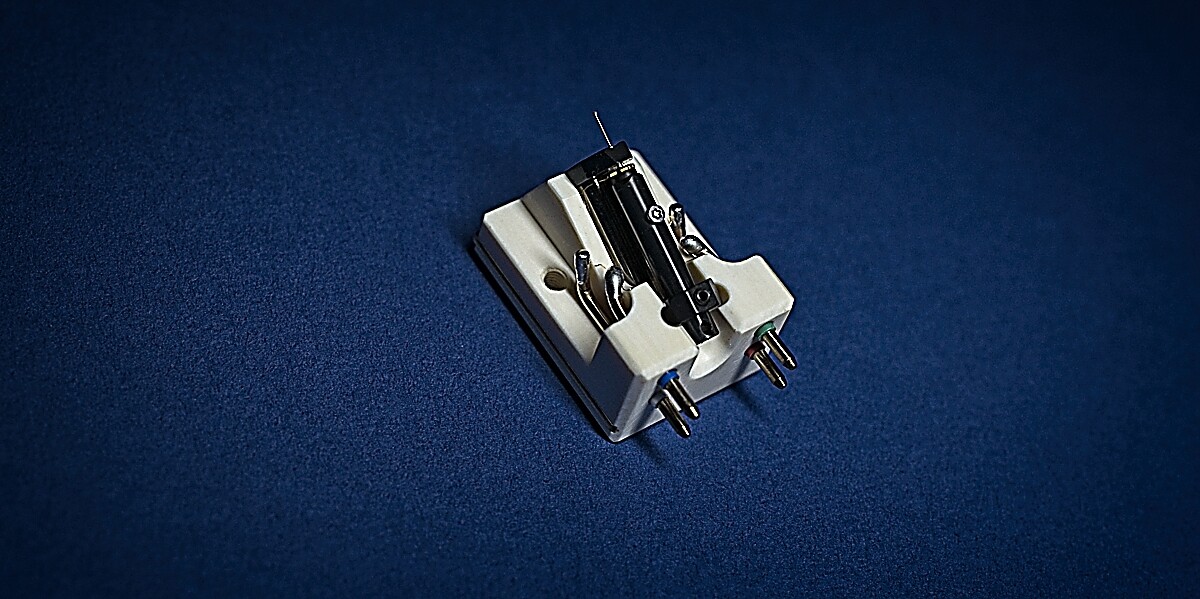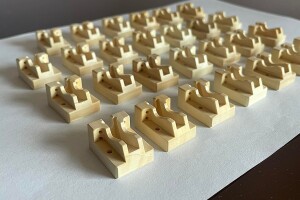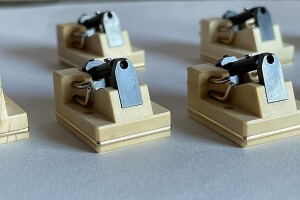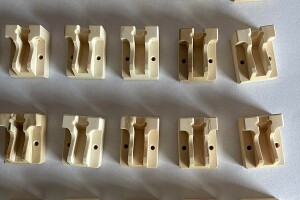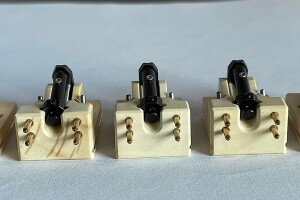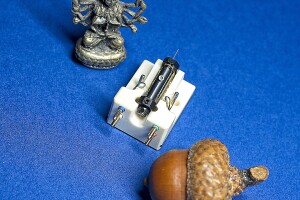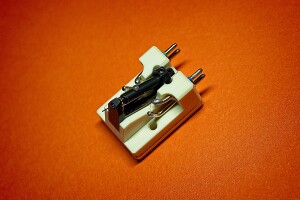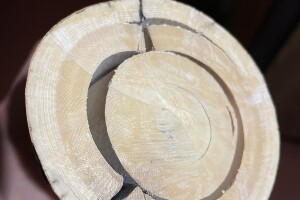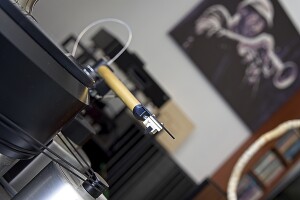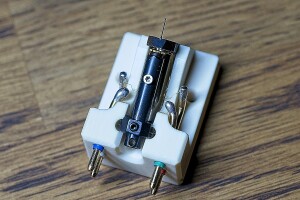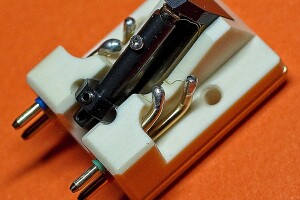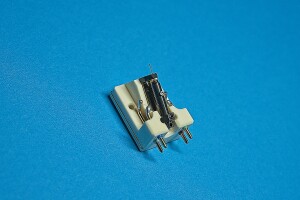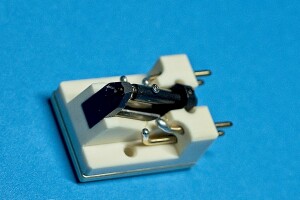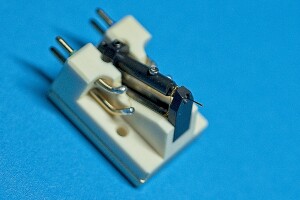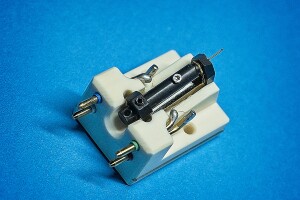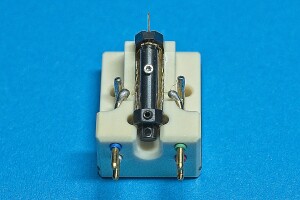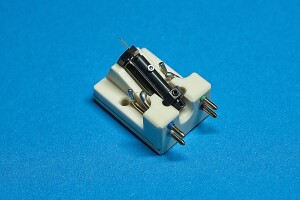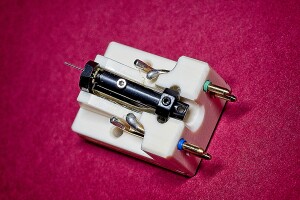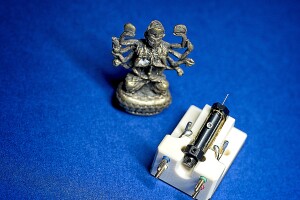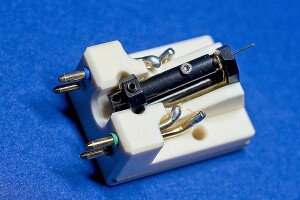If you were asked for the most exotic material for a cartridge body what would it be? Mr. Aidas Svazas for his top model used… a mammoth tusk. Let’s take a closer look at the Aidas Mammoth Gold MC.
Introduction
As a kid, I wanted to be an archeologist. Not a fireman, billionaire, athlete, or rock star but an archeologist, and mind you it was still a „pre-Jurrasic Park”, and even „pre-Riders of the Lost Ark” era. I was fascinated with history, but even more so with its part that remained unknown, that still waited to be discovered. It was only when it came to taking actual steps towards the realization of that dream that I learned more about archaeologists’ everyday routine, and not just about the greatest discoveries and the glory that came with them, and… I realized that I lacked patience for this kind of work. Still, the fascination with the events from the past has remained, and I’ve kept following discoveries concerning human race history, but also our planet’s and the universe’s. What does it all have to do with a review of a cartridge? Patience, we are getting there. For now, let me tell you another (short) story, this time concerning not-that-distant history.
In May this year, for the first time since 2019 thousands of people rushed to Munich for the highly anticipated High End Show. For various reasons participants from some parts of the world still couldn’t make it there which created some openings for brands that otherwise would have had problems getting their own stands. Among them were also numerous Polish brands, some of which made their High End debut. Present were also Show’s veterans and among them the J.Sikora turntables and tonearms manufacturer. Janusz and Robert Sikora presented their highly acclaimed turntables in two rooms. The first of them, let’s call it a „European” one, they shared it with Vitus Audio and SoundSpace Systems (see HERE and HERE). In the second one, say an „American” one, J.Sikora turntable accompanied Doshi Audio electronics and EaglestoneWorks loudspeakers.
In the latter, exhibitors decided to use Lyra Etna SL Lambda cartridge in the J.SIKORA KV12 tonearm. The system was prepared a day or two before the show’s opening, so when I came to listen to it on Thursday morning it was locked and loaded, so to speak. The sound, especially considering it was the very beginning of the Show, was really good. Yet, for my taste (!), it was a bit too bright, too sterile. I knew well the turntable and tonearm, Doshi Audio electronic (phonostage, linestage, and monaural amplifiers) all featured tubes, and while I didn’t know them it seemed unlikely they could have been the reason for my initial impression.
Let me stress it one more time – the sound was good, it just wasn’t „my sound”, nor what I expected. To confirm these initial impressions I came back for another session later this afternoon, shortly before door-closing. I hoped that after the whole day of playing the system’s performance „matured” or „settled” – it’s sort of inherent feature of audio shows and, among other things, a result of fine-tuning that often still takes place on the first day. As it turned out, I missed my chance because the very moment I came in I saw Janusz Sikora replacing Etna with another cartridge. A representative of the Lithuanian manufacturer Aidas Cartridges was there and he brought with him their top model, Mammoth Gold. Imagine my excitement when I found out I was „dealing” with a real archaeological artifact. How come? Well, the body of this cartridge was made of a real woolly mammoth’s tusk.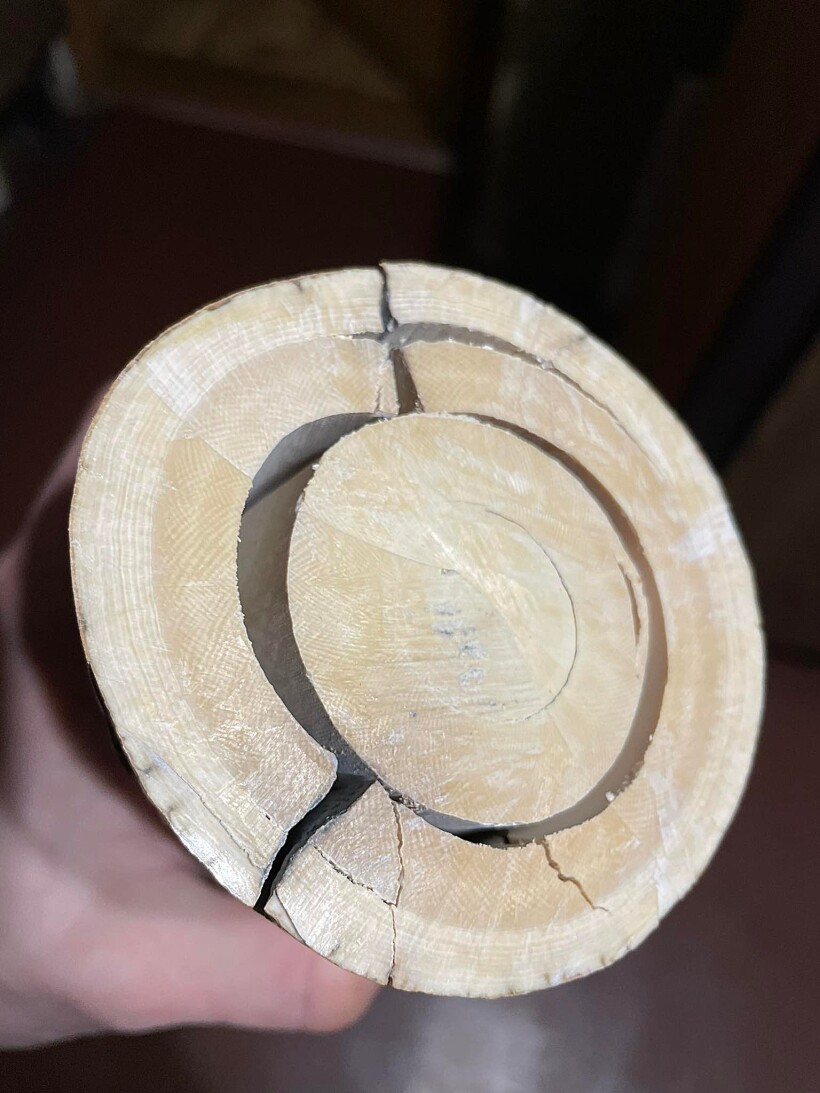
As we all know, climate change, or global warming, if you will, affects the whole world including Earth’s Poles and Arctic Circle. That includes areas of permafrost (in Siberia, Canada, and Alaska). Its melting has made finding artifacts such as bones and tusks of woolly mammoths much easier. Since those are not as rare as in the past anymore, it is possible to buy some and use them for whatever purpose one needs them. Mr. Aidas Svazas has been manufacturing and repairing high-quality cartridges for years. He’s also been using various exotic materials for the bodies of his pickups always looking for those with optimal properties. He reminded me in that the Japanese Koetsu, which has been using natural stones for this purpose for years, or Analog Relax exploring rare types of wood. And while Aidas Cartridges also explores stones, and wood, for their top product they selected an even more exotic material, namely 21000 years old tusk of a woolly mammoth.
Until this review, the oldest material being a part of an audio component reviewed by me was a body of another cartridge, namely the fantastic Analog Relax EX-1000 (see Polish version of the review HERE https://www.highfidelity.pl/@main-4106&lang=). It was made of a very special wood obtained from Yakusugi tree that grows only in one small area in Japan. Very specific, harsh conditions of growth and the long lifespan of these trees (over 2 thousand years!) result in a material offering excellent properties. Since the trees grow in the currently protected areas wood can be acquired only from dead trees, which makes this material very rare and very pricey. Still, it was the properties of this unique wood that made it perfect for this Japanese brand’s top cartridge and I am pretty sure it was one of the reasons why EX-1000 sounded so great (and cost so much). After that experience, I thought that nothing more unique, and definitely nothing ‘older’ would arrive at my doorstep any time soon (if ever). Mammoth Gold, or its manufacturer, proved me wrong.
Now, back to Munich. While I talked shortly to the Aidas Cartridges representative, Janusz Sikora finished the setup of the Mammoth Gold, and right after that I got a chance to listen to the system but only for 2-3 minutes (I don’t even remember what album we listened to). On the one hand, after the whole day spent in numerous rooms listening to various setups, I was a bit tired and slightly overwhelmed with the volume levels in many of them, on the other, I didn’t remember that clearly the sound of this system with Etna, and additionally, right before these 2-3 minutes with Aidas I listened to another remarkable presentation with a reel tape produced by Nagra being a star of it. Yet, despite all of that, my first impression from listening to J.Sikora/Doshi/Eaglestone/Aidas setup was very promising, really good. It seemed to me, that the performance changed quite significantly – the sound was richer, fuller, a bit warmer, hence more natural, more to my liking.
Interestingly, master Sikora himself seemed to agree – he also perceived the change in the same way I did and also found it satisfying his taste (although, to be honest, his fascination with the whole system stemmed, at least in part, from his delight with the excellent phonostage by Doshi). Hence, already after this very short listening session, the decision was made to keep the Mammoth Gold for the rest of the Show. The next day I came again to listen to the whole system some more and I found my initial impressions to be correct – the remarkable class of the performance and a clearly different sonic character (compared to Lyra). Janusz Sikora also liked the cartridge so much that together with his son Robert they decided to become a Polish distributor of the brand. Sometime later I received a small package with the Mammoth Gold, hence I could spend much more time with it and report my findings to you.
Design and features
Aidas Mammoth Gold is a low-level moving coil or MC cartridge. Its name already suggests two key features. The first of them is the body made of a mammoth’s tusk or material obtained from a mammoth’s tusk. With each cartridge, the manufacturer provides a copy of a certificate from an American lab that confirms they tested a tusk from Siberia provided by Aidas. The goal of the test was to use the Carbon-14 dating method to establish the age of the tusk and the result put it at 21.000 years +/- 100. The other part of the name, Gold, indicates that this model belongs to the top Gold, or AU line (both names are used interchangeably). All of the pickups in the line share coils winded using a 24-carat gold wire.
The line includes three models. Apart from the tested one they offer also Baby Mammoth Gold, or a smaller, lighter version of the reviewed cartridge designed for light mass tonearms, and the Gala Gold with its body made of a natural stone, Blue River Agate. There are three more lines in the lineup: CU (copper coils), AG-CU (sliver-plated copper coils), AU-CU (gold-plated copper coils), and each series of cartridges differ with body material and magnet type. In the CU line bodies are made of the so-called Durawood, and one of them is of Panzerwood. In the other two series bodies are made either of wood or natural stones. Click on the manufacturer’s website HERE and have a look for yourselves – in my opinion these are some of the most beautifully made cartridges available on the market today! Actually, the Mammoth Gold compared to many other models looks quite inconspicuously at least until one remembers what it is made of and how old it is.
Mammoth Gold produces an output of 0,28 mV. It features a MicroRidge stylus on a boron cantilever, coils are made of pure gold 999 and it uses AlNiCo5 magnets. Cartridge’s pins are made of brass and finished with pressed 24-carat gold. The recommended tracking force is 1,9g (and that’s what worked best for me), and the loading in the phonostage should be set between 100 and 1000 Ω (I like 300 Ω best). The compliance of 12 um/mN suggests, that Mammoth Gold will work best in medium-mass tonearms.
Two practical notes on Mammoth Gold. First of all, there is no stylus guard. I asked why, and Mr. Aidas answered, that the lack of this element is a result of his experiences. He’s been repairing high-end cartridges for many years and based on information from the customers he learned that many, if not the most, cases of stylus damage happened while the stylus guard was put on or taken off. Hence his decision not to give Mammoth Gold owners a chance to do the same. Me, having such an expensive cartridge, I would like to have a stylus guard and make a choice to use it or not myself, but that’s just me.
Secondly, the box one gets Mammoth Gold in is very practical – it properly protects it while in transport or in storage, and you will find a short manual and a copy of the aforementioned certificate of mammoth tusk’s age. So it’s all good. But… if you take into account the price range and compare the box with the packaging of many, particularly Japanese products, you will realize that it is very modest. Again, after asking about it, I got a quick response that the manufacturer is aware of that and has already been working on a more attractive package. So I guess it should change in the near future. On a practical note – while it is really satisfying to reach for some fancy box that by its looks confirms we bought something nice and pricey, most of us after taking a cartridge out of the box put the latter in a drawer and forget about it. So I never really hold inconspicuous boxes against audio manufacturers who’d rather invest in a product’s performance than the looks of a one-time packaging.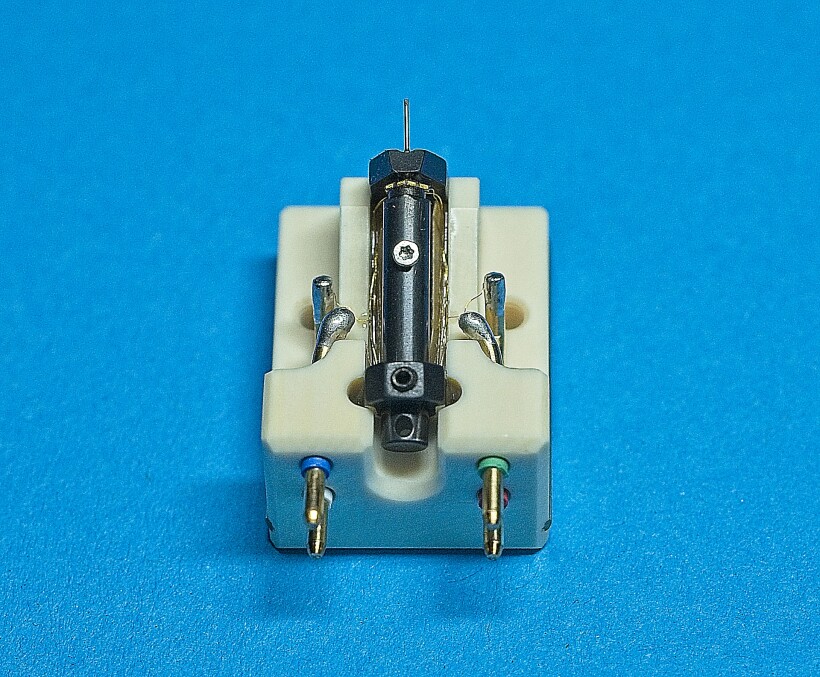
Last but not least, let’s focus for a moment on the quite exotic material for the cartridge’s body. On the manufacturer’s website you can read that, according to Mr. Aidas, the tusk of the woolly mammoth, due to its excellent vibration-damping properties, is the best possible material for the cartridge body. Better than any wood, metal, or natural stone he tested for this very purpose, and if I remember the conversation in Munich correctly, bones of other animals were also tested and it was the mammoth tusk, perhaps due to its age, that offered the best results. Let me remind you once again that in the case of the Aidas cartridges, it is the material of the body that is the main feature distinguishing individual models (the stylus is probably the same in all models). My, surely less extensive, experience also confirms the importance of the material that the pickup’s body is made of, even though it is only one of the building blocks of what we ultimately hear from the speakers. How significant one in this case? Only listening sessions could tell.
Sound
Fine-tuning the cartridge/arm and phono preamp’s settings, including a little play with the VTA (so easy thanks to the on-the-fly adjustments in my KV12) took me a while. At first, the Lithuanian cartridge sounds a bit … too bright to my ears. It is a clear (sic!) signal to me that the settings are still not perfect and that I need to keep working on them. What I hear at this stage contradicts my impressions from Munich, as well as other experiences with audio components featuring gold as one of the key components. Having a chance to experience the performance of a very expensive cartridge I know it is worth it to spend as much time on fine-tuning as necessary – it always pays off.
When I finally arrive at the settings that I consider optimal, I reach for the album that I love and that I often listen to and use in my tests. A funny fact – not that long ago I had a chance to talk to one of the musicians playing on this particular record and he told me the sound was not quite what he’d expected, that a few things did not quite suit him and he would like to change/improve them. His attitude did not prevent this title from gaining considerable popularity in the audiophile world. I’m talking about the album by the Oleś brothers entitled “Spirit of Nadir”.
As soon as the stylus drops into the groove and plays the first notes, I have no doubts that there is not a trace of this previous “brightness” in the sound. Instead, I hear a full, weighted sound, but at the same time fantastically open and spacious. The latter aspect is very important in these recordings, because it creates a ‘desert’ atmosphere, and creates the impression of a huge, open space where the story told with the music takes place. At the same time, the bass goes very low, and its saturation, and energy, also at the lowest notes, are exceptional. As in this case it is an acoustic bass, inherently not particularly tight, it has a certain natural (!) softness to it. Despite that, it gives me a foretaste of how well the lower part of the band (as well as the other ones, but more on that later) is differentiated by the Aidas. Perfectly differentiated in terms of both, timbre and dynamics, I might add. The phase of slightly soft attack and sustain is well marked, but the biggest impression is made by the long, full decay.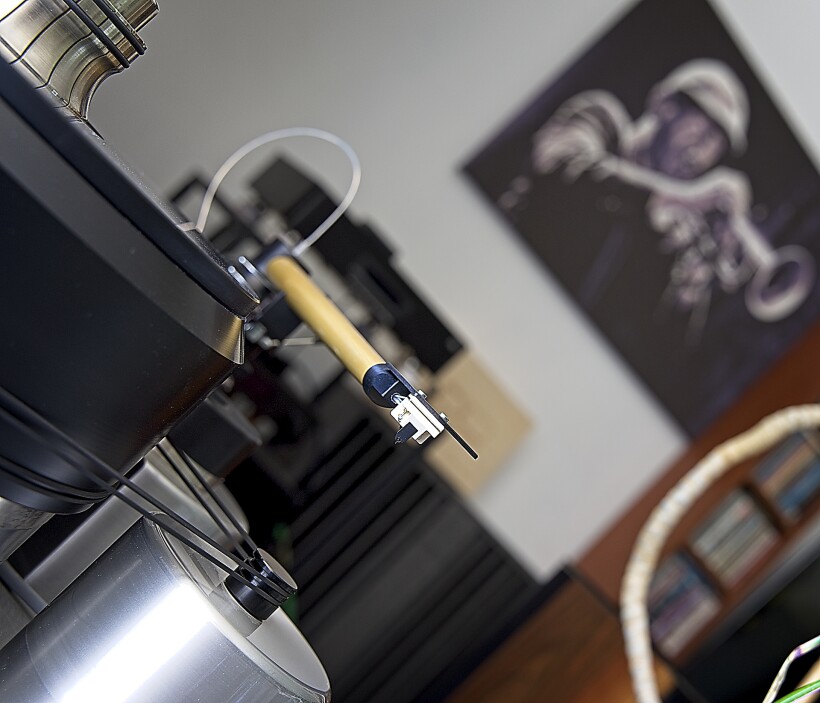
Same as later, on Garbarek’s “Legend of The Seven Dreams” album, it is clear that the sound (its center of gravity) is placed quite low, that it is a bit warm, in other words not as neutral as with my Air Tight PC-3, or with one of the best cartridges I know, Murasakino Sumile (see HERE http://hifiknights.com/reviews/sources/murasakino-musique-analogue-sumile-mc/). However, I do not perceive it as an issue or weakness of this performance, but rather as its feature, one that, in my ears, is highly desirable, giving this cartridge, which is already clear at this stage, its unique character. A character that is truly listener-friendly, if I may say soy, but I’m talking about the ‘friendliness’ achieved through naturalness and accuracy of the sound, not simplifications, smoothing it out, or adding more warmth to it.
It is this naturalness, fluidity, and coherence, next to saturation and smoothness, that turn out to be the dominant features of this presentation. That’s why the Mammoth Gold reminds me more of the already mentioned Analog Relax EX-1000 (also because of the absolutely top-class performance), or (albeit more in terms of character, because they are slightly inferior in class) cheaper models of this Japanese brand, or Koetsu (for example Black Gold, which I owned years ago). Although this is a bit of a simplification, let me risk saying that a lot of the sonic character of this pickup can be most likely attributed to the coils made of gold wire. It is worth noting that I find in this sound all the advantages associated with this material, but not the disadvantages such as slowing down the pace or too much smoothing, warming, and rounding of the sound. Each material has its advantages and disadvantages, and the best components are developed when their creators manage to maximize the potential of the former and minimize the latter. Already at this stage of the listening sessions, it is clear that the tested Aidas’ cartridge is such a case.
The culmination of my double-bass-focused listening session this time is not one of the Ray Brown’s or Christian McBride’s albums that I often use on such occasions (the latter not that long ago played a fantastic concert as part of the Warsaw Summer Jazz Days), but the newly acquired album “Alone Together” … also by Marcin and Bartłomiej Oleś. The album is quite unusual, if only because it has B (Bartłomiej) and M (Marcin) sides, to emphasize that neither of them is the first or the second one. Each of the brothers recorded pieces for one side playing solo on their respective instruments. And since the recording and release/pressing are very good, studying the mastery of both men and the sound of both drums and double bass is made easy.
On the same disc, on the M side, the reverbs, the depth of the double bass and the huge richness or variety of sounds that our excellent musician can extract from it is perfectly audible. The tested cartridge freely reproduces the size and mass of the double bass, the lowest, weighted, but also the higher, lighter, lively, agile sounds. With all the naturalness and “friendliness” of the presentation, the Mammoth Gold is able to present its remarkable capabilities in terms of resolution and differentiation, serving a huge (which may be surprising at first, considering that we listen to a single instrument) amount of details, subtleties, and flavors. The album is also unique because the lack of other sounds/instruments emphasizes the uniqueness of the musician playing on a given side more than usual. It is after listening to this side of the Oleś album (although there is still a lot of listening ahead of me) that I decide that the Aidas Mammoth Gold is one of the absolutely best cartridges for acoustic music I know, offering a fabulously full, rich and natural, almost organic sound.
The unique, let me be bold, top (!) class of the Mammoth Gold is evidenced by the combination of the already described features of the lower end with not only extraordinary refinement, but also sonority, energy, and openness of the upper part of the band. I can clearly hear it on the B side of the album, in the Bartłomiej cymbals, and the treble turns out even more impressive on the album that the Oleś brothers recorded together with Dominik Strycharski, entitled “Koptycus” (the package with these two albums arrived shortly before I started to listen to Aidas, hence I could use them for this test). As is the case with the best tube amplifiers (read SETs), the treble is smooth, delicate, and weighted, but at the same time saturated with high energy, powerful and snappy when needed, and filled with precisely yet subtly presented information. The sounds roam free on the air-filled, open stage, and, as I’ve mentioned already, the reverberation, decay, and all other acoustic cues present in played recordings (live or studio ones) are equally well conveyed.
Although it seems to me so from the start, the more albums I listen to the more sure I am that the Mammoth Gold is a different beast altogether than the aforementioned Murasakino Sumile, or the Air Tight Opus 1 (just to mention the top ones I know). The latter two offer absolutely breathtaking resolution, transparency, and purity in the treble area, without even the slightest sign of brightness or sharpness. The Lithuanian cartridge, on the other hand, “gold-plates” the treble just a bit. On the one hand, this means that it is more weighted and even richer, on the other hand, velvety smooth and natural and delivered with high energy. Listening to, for example, brass instruments, it becomes obvious that Aidas puts a bit more emphasis on sustain and decay than on the immediacy and hardness of the attack. Interestingly, the tested cartridge is able to reproduce the proper sharpness of the trumpet, even on Tomasz Stańko album which only makes it sound even more natural, and more real.
I used the term “accurate” earlier because that’s what I am dealing with here. The Mammoth Gold does not do anything by force or just for show, and “only” plays back what is stored in the groove, what is necessary at the moment for the instruments or vocals to sound real. It achieves this without over-analyzing small details, reading them all perfectly from the record, but combining them with extreme care into a larger, coherent, rich whole. This is a great achievement, especially considering the fact that the Lithuanian cartridge does it in a less „showy”, less direct way than Murasakino Sumile or Air Tight Opus 1. The impatient audiophile, after a short listening session, will probably choose one of the latter (or other similar ones), but those who shall spend enough time to get to know them sooner or later will appreciate how refined and even organic and at the same time non-fatiguing, designed for long-distance runners (i.e. people who prefer longer listening sessions) the sound offered by the Mammoth Gold really is.
Hence, a strong (especially rock) beat of a drumstick against a cymbal or an electric guitar string will probably make a greater first impression with the Murasakino or the Air Tight Opus 1 (I use these two as representative of the top-high-end level that I know). However, Aidas, behind this perhaps slightly less impressive impulse/attack, provides so much information about the response of the cymbal, the air vibrating around the cymbal and carrying the sound to … the microphone, but ultimately to our ears, that in effect it delivers at least as exciting and rich, though slightly different, musical experience, as the other two pickups. Using a culinary comparison, I would say that the “taste” of Air Tight and Murasakino attacks the senses from the first contact and is strong, and intense, while the one of Mammoth Gold slowly melts on the tongue, and the fullness and richness of the “taste” reaches us only after a short while. The accents are distributed differently, but the end result is as delicious in each case and one that is difficult to forget. Let me add that in terms of this combination of smoothness and richness of the treble, its refinement, and clarity, the tested cartridge reminded me of the Kondo IO-XP I recently tested (along with the company’s phono and step-up, both in silver versions), and also the aforementioned Analog Relax EX- 1000.
I’ve already written a lot about the bottom and top of the band, although everything in the presentation of the Aidas Mammoth Gold actually revolves around the midrange, so to speak. This is not surprising, to be clear because it is the most important part of the band in any kind of music. During my listening sessions, there were also some albums with excellent vocal performances, so far overlooked in the description – Patricia Barber, Eva Cassidy, Luciano Pavarotti, and Leontyna Price, but also Muddy Waters, Rysio Riedel, and David Gilmour. Jazz, blues, rock, and finally classical music – it didn’t make much difference to the Lithuanian cartridge. It presented all the vocals in a wonderfully present, tangible, expressive, “moist” way, making listening to them a highly engaging, emotional experience. The timbre, texture, and vocal manners of each of the above-mentioned and many other artists were presented in an absolutely convincing and true (or at least giving such a vibe, since I was not present when had been recorded) way. And yes, that’s something that should be considered a must for every cartridge from this price range.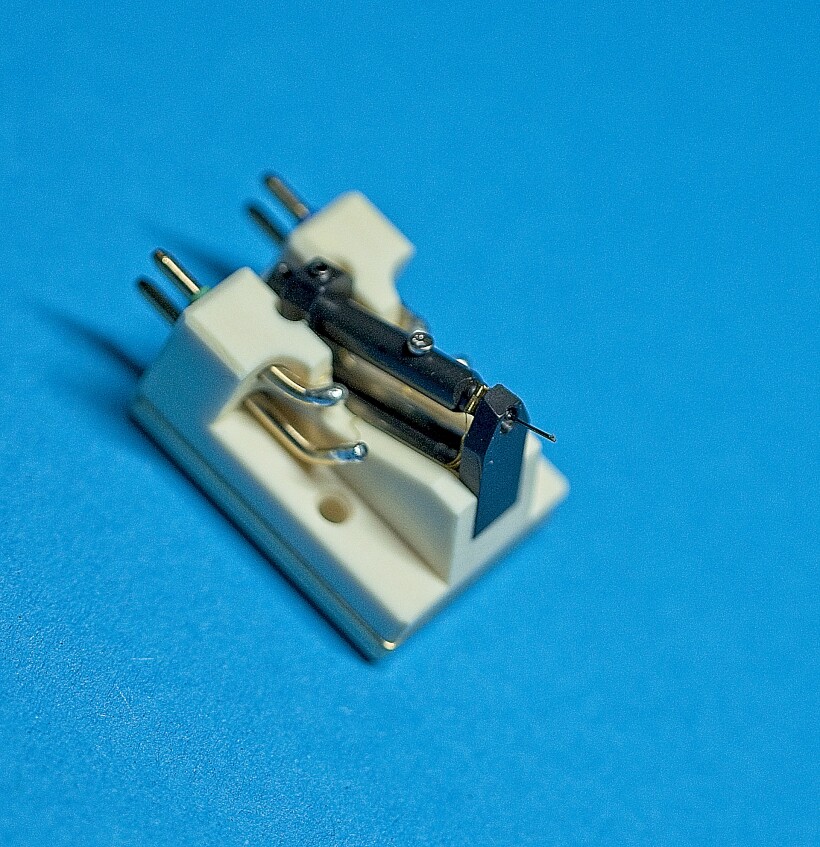
Nevertheless, apart from acoustic music, the vocals can be considered the particularly valuable quality, if not a specialty, of the Golden Mammoth. Specialization, i.e. something in which it is slightly (because at this top-level performance, we are talking about really small differences between competing cartridges) better than competitors, who in turn have their own slight advantages elsewhere. So I listened to each album of my favorite singers with Aidas truly focused and involved from the first to the very last second. In this regard, these experiences reminded me of participating in concerts, which for me is the ultimate musical experience. I have mentioned many, many times before that this is the kind of sound I am looking for, i.e. as close to live music as possible.
Of course, there is no such thing as absolutely universal solutions/components in audio. So when it came to rock concerts and studio albums that needed to be delivered in a powerful, hard way, with an outstanding drive, given the choice between Aidas or the aforementioned Murasakino Sumile, I would probably choose the latter. This does not change the fact that on the JSikora Standard Max turntable, unparalleled in terms of dynamics, drive and PRAT (tempo, rhythm, and timing) and the fantastic KV12 tonearm, the Mammoth Gold was also able to present the wild performances of, say, AC/DC, Aerosmith or Metallica in a way that forced my limbs to tap the rhythm, my head was rocking and I found myself singing along with the singers (causing misery for my neighbors). It’s just that, while in acoustic and vocal music Aidas had a slight advantage, these „rock” albums Murasakino Sumile or Air Tight Opus 1 were able to present in an even better, more “rocking” way.
However, when it came to a bit more mellow music, also blues, the Lithuanian cartridge, which presented the midrange so well, charmed me with the density of electric guitars, and strong, if necessary, slightly hoarse, highly expressive vocals. Maybe not so spectacularly, but with a perfect “feeling” it conveyed the pace and rhythm, and there was no reason at all to complain about the timing. Especially my beloved blues was presented by the Aidas in a highly emotional, truly immersive way, forcing me to reach for more albums of this genre, including those that had already got a bit dusty on the shelves. Even though it does not depend too much on the cartridge, all the quiet evening listening sessions gave me as much satisfaction as daily ones that involve significantly higher volume levels. Also because the Mammoth Gold is a fairly quiet cartridge, it does not tend to emphasize the pops and cracks on the records, and when they do appear, they never come to the fore, they don’t grab the attention turning it thus away from music.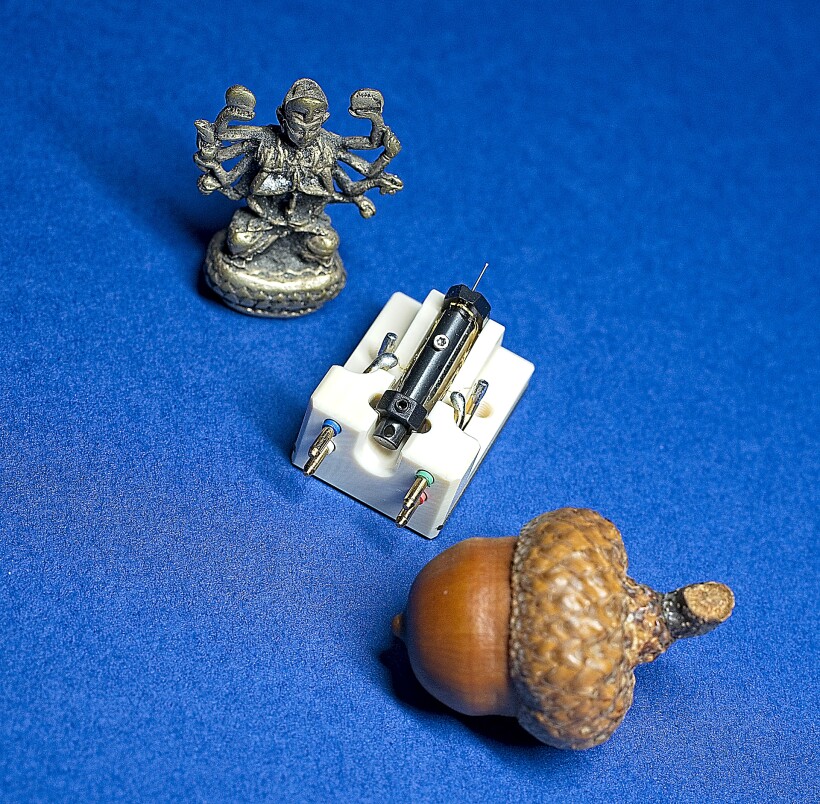
Summary
Aidas Mammoth Gold is one of the most expensive cartridges I’ve ever had the opportunity to listen to in my system and one of the absolute best. The point is not in the fact that the price determines the class of an audio product by itself because in audio there is no such unambiguous correlation. It is clear to me that its designer is, like me, primarily a music lover. The number one goal was (I believe) to offer a cartridge that would draw listeners into the world of music and kept them there. One that would convey every last of the details and subtleties read from the grooves, yet it is not them, but the rich whole they combine into, including the important emotional layer, that is supposed to catch the listeners’ attention and appeal to their sensitivity. The music genre is not of great importance with the Golden Mammoth, although, as I’ve mentioned, heavier rock or metal albums will probably sound even more convincing with some other top cartridges.
The quality of the recordings/pressings is of some importance because it is a cartridge that perfectly differentiates this aspect as well, but the purchase of the Mammoth Gold will not force you to throw away those of less-than-perfect quality, because they, or at least most of them, will sound good considering what they have to offer, probably even better than usual (i.e. with other top, but more „ruthless” competitors, maybe apart from the EX-1000). The top proposal of the Aidas brand is expensive and even at such a high price level there is no shortage of competitors, and the choice is not easy. Nevertheless, if you are one of those people who love music and prefer to spend time experiencing it in the most refined, engaging, accurate way possible, not focusing on the analysis of recordings and pressings, but on the music itself, the Aidas Mammoth Gold is, in my opinion, one of the absolutely best available choices.
And it is already available in Poland thanks to JSikora. Since the Lublin manufacturer of top turntables and tonearms will soon open the doors of a carefully prepared listening room (in its headquarters), those willing to check the Aidas cartridges out will be able to go there. It will give you a chance to experience the magic of a 21,000-year-old mammoth tusk mounted in the Kevlar tonearm on a heavy metal drive, all in the service of MUSIC. In my opinion, when looking for a top cartridge for a high-end system (you need a turntable, tonearm, and phonostage from the top shelf as well) you simply have to add the Aidas Mammoth Gold to your „must check out” list. For me, it is the second, after Murasakino Sumile, a cartridge that fully deserves our Victor!
Technical specifications (according to the manufacturer):
- Body: Mammoth tusk
- Cantilever: Namiki / adamant boron
- Stylus: MicroRidge
- Output: 0,28 mV
- Magnet system: AlNiCo5
- Pins: 24-carat pressed gold (brass base)
- Tracking force: 1,9 g
- Lateral compliance: 12 um/mN
- Cartridge weight: 11.2 g
- Recommended loading: 100 – 1000 Ω
- Coils: pure 999 gold 0,04 mm
- Coil compliance: 3 Ω
- Recommended tonearm mass: medium
Price (when reviewed):
- AIDAS CARTRIDGES MAMMOTH GOLD: 85o0 EUR
Manufacturer: AIDAS CARTRIDGES
Polish distributor: JSIKORA
Associated equipment:
- Digital source: a custom passive server with WIN10, Roon, Fidelizer Pro 7.10, JCAT NET XE, and JCAT USB XE cards with FERRUM HYPSOS Signature power supply, KECES P8 (mono) linear power supply for the server, JCAT USB Isolator
- D/A Converter: LampizatOr Pacific +Ideon Audio 3R Master Time (USB signal regenerator)
- Analog front end: J.Sikora Standard MAX turntable, J.Sikora KV12 tonearm, AirTight PC-3, phono stages: Grandinote Celio MK IV, ESE Lab Nibiru V 5.
- Power amplifiers: GrandiNote Shinai, Circle Labs M200
- Preamplifier: Circle Labs P300
- Loudspeakers: GrandiNote MACH4, Ubiq Audio Model ONE Duelund Edition.
- Interconnects: Bastanis Imperial x2, Soyaton Benchmark, Hijiri Million, Hijiri HCI-20, TelluriumQ Ultra Black, KBL Sound Zodiac XLR, David Laboga Expression Emerald USB, David Laboga Digital Sound Wave Sapphire Ethernet
- Speaker cables: Soyaton Benchmark
- Power cables: LessLoss DFPC Signature, Gigawatt LC-3
- Power: Gigawatt PF-2 MK2 and Gigawatt PC-3 SE Evo+; a custom power line with Gigawatt LC-Y in-wall cable; Gigawatt G-044 Schuko and Furutech FT-SWS-D (R)
- Network: Silent Angel Bonn N8 + Silent Angel Forester F1 + optical LAN isolator
- Racks: Base VI, Rogoz Audio 3RP3/BBS
- Anti-vibration accessories: ROGOZ-AUDIO SMO40 and CPPB16 platforms and ROGOZ AUDIO BW40MKII feet, Franc Accessories Ceramic Disc Slim Feet and Wood Block Platform, Graphite Audio CIS-35 and IC-35


